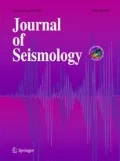Abstract
A seismically active region is modelled as a system of absolutely rigid blocks separated by infinitely thin plane faults. The interaction of the blocks along the fault planes and with the underlying medium is viscous-elastic. The system of blocks moves as a consequence of prescribed motion of the boundary blocks and of the underlying medium. When for some part of a fault plane the ratio of the stress to the pressure exceeds a certain strength level a stress-drop (‘a failure’) occurs (in accordance with the dry friction model), and it can cause a failure in other parts of the fault planes. In the model the failures represent earthquakes. As a result of the numerical simulation a synthetic earthquake catalog is produced. The numerical modelling was carried out for three types of structures with increasing of the structure separateness inside of each type and for two types of boundary movements. A synthetic earthquake flow is characterised by several features including the frequency-magnitude relation (the Gutenberg-Richter curve). When the structure separateness increases the slope of the curve changes monotonously in the same direction for all considered types of structures if the boundary movement is the same. The directions of changing of the slope are opposite for two considered boundary movements.
Similar content being viewed by others
References
Allegre, C. J., Le Mouel, J.-L., Chau, H. D., and Narteau, C., 1995, Scaling organization of fracture tectonics (SOFT) and earthquake mechanism. Phys. Earth. Planet. Inter. 92: 215–233.
Bariere, B., and Turcotte, D. L., 1994, Seismicity and self-organized criticality, Phys. Rev. E. 49, 1151–1160.
Gabrielov, A. M., Levshina, T. A., and Rotwain, I. M., 1990, Block model of earthquake sequence, Phys. Earth and Planet. Inter. 61: 18–28.
Gabrielov, A., Kossobokov, V., and Soloviev, A., 1994, Numerical simulation of block structure dynamics. In Seismicity and Related Processes in the Environment, Vol. 1. M.: Research and Coordinating Centre for Seismology and Engineering: 22–32.
Gutenberg, B., and Richter, C. F., 1956, Earthquake magnitude, intensity, energy and acceleration, Bull. Seism. Soc. Am. 46: 105–145.
Hattori, S., 1974, Regional distribution of b-value in the world. Bull. Intern. Inst. Seismol. and Earth Eng. 12: 39–58.
Kronrod, T. L., 1984, Seismicity parameters of the main regions of the high seismic activity. In V. I. Keilis-Borok, and A. L. Levshin (eds.), Logical and Computational Methods in Seismology. Moscow: Nauka: 36–57 (Comput. Seismol.; Iss. 17, in Russian).
Mogi, K., 1962, Magnitude-frequency relation for elastic shocks accompanying fractures of various materials and some related problems in earthquakes. Bull. Earthq. Inst. Tokyo Univ. 40: 831–853.
Newman, W. I., Turcotte, D. L. and Gabrielov, A. M., 1995, Logperiodic behaviour of a hierarchical failure model with application to precursory seismic activation. Phys. Rev. E. 52: 4827–4835.
Panza, G. F., Soloviev, A. A. and Vorobieva, I. A., 1997, Numerical Modelling of Block-Structure Dynamics: Application to the Vrancea Region. PAGEOPH 149: 313–336.
Shaw, B. E., Carlson, J. M., and Langer, J. S., 1992, Patterns of seismic activity preceding large earthquakes. J. Geophys. Res. 97: 479.
Shamina, O. G., Budnikov, V. A., Vinogradov, S. D., Volazovich, M. P. and Tomashevskaya, I. S., 1980, Laboratory experiments on the Physics of the earthquake source. In Physical Processes in Earthquake Sources. Moscow: Nauka: 56–68 (in Russian).
Sherman, S. I., Borniakov, S. A., and Buddo, V. Yu., 1983, Areas of Dynamic Effects of Faults. Novosibirsk: Nauka: 111 pp. (in Russian).
Sobolev, P. O., Soloviev, A. A., and Rotwain, I. M., 1996, Modelling of lithosphere dynamics and seismicity for the Near East region. In V. I. Keilis-Borok, and G. M. Molchan (eds.), Modern Problems of Seismicity and Earth Dynamics. Moscow: Nauka: 131–147 (Comput. Seismol.; Iss.28, in Russian).
Soloviev, A. A., 1995, Modeling of block structure dynamics and seismicity. In European Seismological Commission, XXIV General Assembly, 1994 September 19-24, Athens, Greece, Proceedings and Activity Report 1992-1994, Vol. III: University of Athens, Faculty of Sciences, Subfaculty of Geoscsiences, Department of Geophysics & Geothermy: 1258–1267.
Utsu, T., and Seki, A., 1954. A relation between the area of aftershock region and the energy of main shock, J. Seism. Soc. Japan 7: 233–240.
Turcotte, D. L., 1992, Fractals and Chaos in Geophysics. Cambridge: Cambridge University Press.
Author information
Authors and Affiliations
Rights and permissions
About this article
Cite this article
Keilis-Borok, V.I., Rotwain, I.M. & Soloviev, A.A. Numerical modeling of block structure dynamics: dependence of a synthetic earthquake flow on the structure separateness and boundary movements. Journal of Seismology 1, 151–160 (1997). https://doi.org/10.1023/A:1009717607645
Issue Date:
DOI: https://doi.org/10.1023/A:1009717607645



